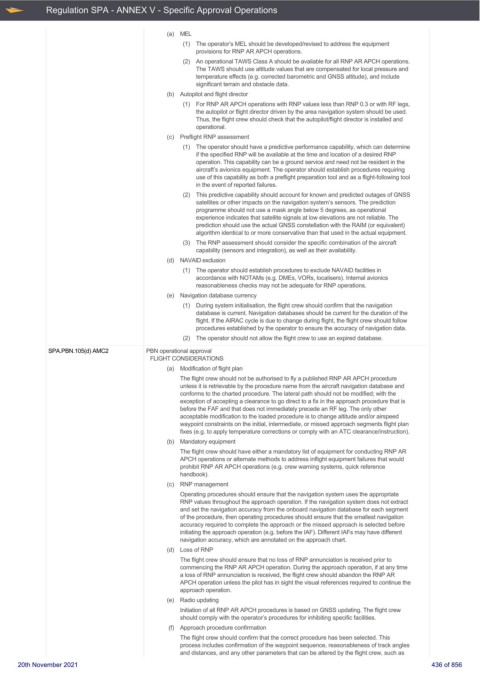Page 436 - UK Air Operations Regulations (Consolidated) 201121
P. 436
~
~ Regulation SPA - ANNEX V - Specific Approval Operations Centrik
(a) MEL
(1) The operator’s MEL should be developed/revised to address the equipment
provisions for RNP AR APCH operations.
(2) An operational TAWS Class A should be available for all RNP AR APCH operations.
The TAWS should use altitude values that are compensated for local pressure and
temperature effects (e.g. corrected barometric and GNSS altitude), and include
significant terrain and obstacle data.
(b) Autopilot and flight director
(1) For RNP AR APCH operations with RNP values less than RNP 0.3 or with RF legs,
the autopilot or flight director driven by the area navigation system should be used.
Thus, the flight crew should check that the autopilot/flight director is installed and
operational.
(c) Preflight RNP assessment
(1) The operator should have a predictive performance capability, which can determine
if the specified RNP will be available at the time and location of a desired RNP
operation. This capability can be a ground service and need not be resident in the
aircraft’s avionics equipment. The operator should establish procedures requiring
use of this capability as both a preflight preparation tool and as a flight-following tool
in the event of reported failures.
(2) This predictive capability should account for known and predicted outages of GNSS
satellites or other impacts on the navigation system’s sensors. The prediction
programme should not use a mask angle below 5 degrees, as operational
experience indicates that satellite signals at low elevations are not reliable. The
prediction should use the actual GNSS constellation with the RAIM (or equivalent)
algorithm identical to or more conservative than that used in the actual equipment.
(3) The RNP assessment should consider the specific combination of the aircraft
capability (sensors and integration), as well as their availability.
(d) NAVAID exclusion
(1) The operator should establish procedures to exclude NAVAID facilities in
accordance with NOTAMs (e.g. DMEs, VORs, localisers). Internal avionics
reasonableness checks may not be adequate for RNP operations.
(e) Navigation database currency
(1) During system initialisation, the flight crew should confirm that the navigation
database is current. Navigation databases should be current for the duration of the
flight. If the AIRAC cycle is due to change during flight, the flight crew should follow
procedures established by the operator to ensure the accuracy of navigation data.
(2) The operator should not allow the flight crew to use an expired database.
SPA.PBN.105(d) AMC2 PBN operational approval
FLIGHT CONSIDERATIONS
(a) Modification of flight plan
The flight crew should not be authorised to fly a published RNP AR APCH procedure
unless it is retrievable by the procedure name from the aircraft navigation database and
conforms to the charted procedure. The lateral path should not be modified; with the
exception of accepting a clearance to go direct to a fix in the approach procedure that is
before the FAF and that does not immediately precede an RF leg. The only other
acceptable modification to the loaded procedure is to change altitude and/or airspeed
waypoint constraints on the initial, intermediate, or missed approach segments flight plan
fixes (e.g. to apply temperature corrections or comply with an ATC clearance/instruction).
(b) Mandatory equipment
The flight crew should have either a mandatory list of equipment for conducting RNP AR
APCH operations or alternate methods to address inflight equipment failures that would
prohibit RNP AR APCH operations (e.g. crew warning systems, quick reference
handbook).
(c) RNP management
Operating procedures should ensure that the navigation system uses the appropriate
RNP values throughout the approach operation. If the navigation system does not extract
and set the navigation accuracy from the onboard navigation database for each segment
of the procedure, then operating procedures should ensure that the smallest navigation
accuracy required to complete the approach or the missed approach is selected before
initiating the approach operation (e.g. before the IAF). Different IAFs may have different
navigation accuracy, which are annotated on the approach chart.
(d) Loss of RNP
The flight crew should ensure that no loss of RNP annunciation is received prior to
commencing the RNP AR APCH operation. During the approach operation, if at any time
a loss of RNP annunciation is received, the flight crew should abandon the RNP AR
APCH operation unless the pilot has in sight the visual references required to continue the
approach operation.
(e) Radio updating
Initiation of all RNP AR APCH procedures is based on GNSS updating. The flight crew
should comply with the operator’s procedures for inhibiting specific facilities.
(f) Approach procedure confirmation
The flight crew should confirm that the correct procedure has been selected. This
process includes confirmation of the waypoint sequence, reasonableness of track angles
and distances, and any other parameters that can be altered by the flight crew, such as
20th November 2021 436 of 856

